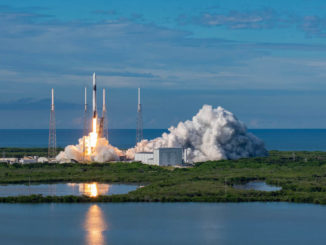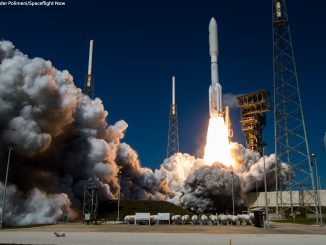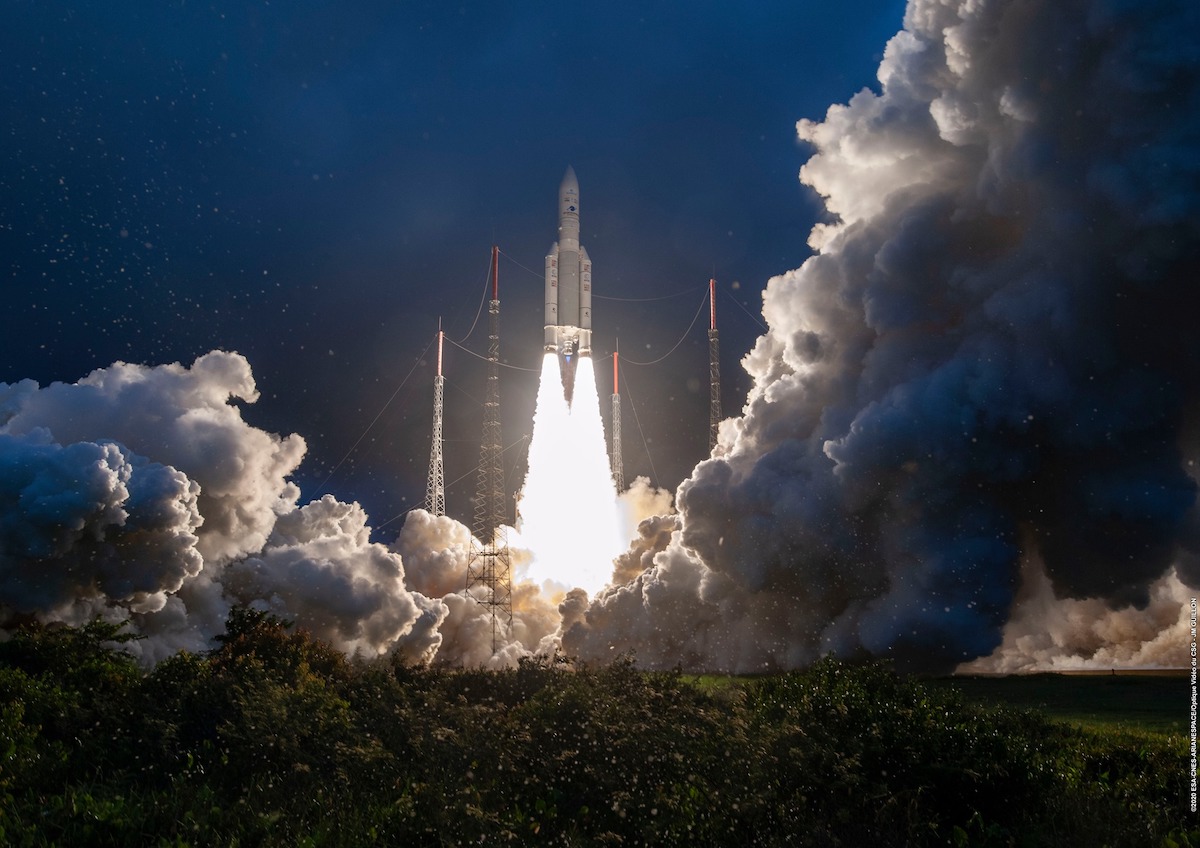
The first of up to 22 launches on Arianespace’s schedule in 2020 successfully delivered a commercial European broadband satellite and an Indian communications payload to orbit Thursday using a heavy-lift Ariane 5 rocket.
The nearly 180-foot-tall (54.8-meter) rocket, propelled by two side-mounted solid-fueled boosters and a hydrogen-fueled core stage, fired away from the ELA-3 launch pad in Kourou, French Guiana, at 4:05 p.m. EST (2105 GMT; 6:05 p.m. French Guiana time) Thursday.
Arcing toward the east, the powerful Ariane 5 launcher surpassed the speed of sound in less than a minute as it darted through low clouds hanging over the tropical space base on the northeastern shore of South America.
The solid rocket boosters jettisoned less than two-and-a-half minutes into the flight, and the Ariane 5 released its Swiss-built nose shroud moments later once the launcher climbed above the thick, lower layers of the atmosphere.
The Ariane 5’s Vulcain 2 main engine shut down nearly nine minutes into the mission, and the first stage separated to fall into the Atlantic Ocean west of Africa. An HM7B engine on the second stage ignited to accelerate the mission’s two satellite payloads into an elliptical transfer orbit stretching more than 22,000 miles (nearly 36,000 kilometers) above Earth.
After shutting down the second stage engine, the Ariane 5 deployed the Eutelsat Konnect satellite — designed to provide broadband signals to customers in Europe and Africa — then released the Indian GSAT 30 communications spacecraft a few minutes later.
Officials declared the mission a success, opening a busy year for Arianespace that could include the debut launches of Europe’s upgraded Vega C rocket — a larger version of the Vega launcher currently in the company’s fleet — and the new-generation Ariane 6 launch vehicle.
In addition to the possible debuts of the Vega C and Ariane 6, Arianespace plans up to 12 Ariane 5, Soyuz and Vega launches from French Guiana this year. And there are eight flights of Russian-made Soyuz rockets scheduled under the auspices of Arianespace from launch site at the Baikonur Cosmodrome in Kazakhstan and the Vostochny Cosmodrome in Russia, each carrying more than 30 broadband satellites to low Earth orbit for OneWeb.
If all the launches proceed as planned this year, Arianespace says it will place more than 300 satellites into orbit, including the clusters of OneWeb payloads on Soyuz missions, and a rideshare launch on a Vega rocket from French Guiana in March carrying more than 40 small satellites.
Arianespace says it could perform missions from up to six launch pads in 2020 — four at the Guiana Space Center in South America for the Ariane 5, Ariane 6, Soyuz and Vega rockets, and one each at Baikonur and Vostochny.
The record number of missions for the French launch services provider in a single year is 12, which the company set in 2015.
Arianespace performed nine launches last year — all from French Guiana — including a failed mission with a Vega launcher in July, which destroyed the Falcon Eye 1 Earth-imaging satellite for the United Arab Emirates.

The Italian-built Vega rocket is scheduled to resume launches in March with a multi-payload commercial rideshare flight into polar orbit from the Guiana Space Center.
Before then, Arianespace plans to launch its first full-scale mission for OneWeb from the Baikonur Cosmodrome using a Soyuz booster and Fregat upper stage. The launch with 34 OneWeb broadband satellites is scheduled for no earlier than Feb. 7.
In mid-February, an Ariane 5 rocket is scheduled to launch from French Guiana with the Lockheed Martin-built, Japanese-owned JCSAT 17 communications satellite and the South Korean GEO-Kompsat 2B ocean monitoring spacecraft.
And a Soyuz rocket is scheduled to lift off from French Guiana as soon as March 5 with the UAE military’s Falcon Eye 2 Earth-imaging satellite, which was swapped from a Vega rocket in the wake of last year’s launch failure.
Among other missions, a Vega launch this year will loft the Spanish Ingenio Earth observation spacecraft and the French Taranis scientific satellite on a single launch. A passive Italian research payload names LARES 2 will ride the inaugural launch of the uprated Vega C rocket later in 2020.
A Soyuz rocket launched from French Guiana later this year is scheduled to loft the second in a series of three new-generation high-resolution spy satellites for the French military.
Payload assignments for additional Ariane 5 launches later this year have not been announced.
Amid the launch activity in French Guiana, Arianespace and Russian teams aim to hit a cadence of of up to eight Soyuz flights with OneWeb satellites from Baikonur and Vostochny. Up to two additional Soyuz launches from French Guiana this year could also carry OneWeb spacecraft into orbit.
Assuming development remains on track, the first flight of Europe’s new Ariane 6 rocket late this year will launch another batch of OneWeb broadband satellites.
OneWeb, headquartered in London, is launching its initial network of 650 broadband satellites to enable low-latency, high-speed Internet connectivity for customers around the world, including aviation, maritime and other transportation sectors. The company’s satellites are manufactured in Florida in a purpose-built factory just outside the gates of NASA’s Kennedy Space Center.
The Ariane 6 will come in two configurations: Ariane 62 with two strap-on solid rocket boosters, and Ariane 64 with four boosters clustered around its first stage engine.
The first Ariane 6 mission in late 2020 will use the Ariane 62 version.
Arianespace says it has more than 50 total launches in its backlog, with OneWeb as the company’s single biggest customer.
Thursday night’s launch of an Ariane 5 rocket carried satellites for two of Arianespace’s other regular customers: Eutelsat and the Indian Space Research Organization.
The Ariane 5 targeted delivery of the Eutelsat Konnect and GSAT 30 satellites to an elliptical geostationary transfer orbit ranging between 155 miles (250 kilometers) and 22,220 miles (35,761 kilometers), with an orbit tilted 6 degrees to the equator.
Arianespace confirmed the rocket hit its target and deployed both satellites within about 40 minutes of liftoff, and officials from Eutelsat and ISRO said ground teams established contact with the spacecraft soon after their separation from the Ariane 5’s upper stage.
Each satellite will use its own propulsion to circularize its orbit at geostationary altitude more than 22,000 miles over the equator, where their velocities will match the rate of Earth’s rotation, giving each spacecraft a fixed geographic coverage zone.
The Eutelsat Konnect satellite was the largest of the two payloads on Thursday’s mission.
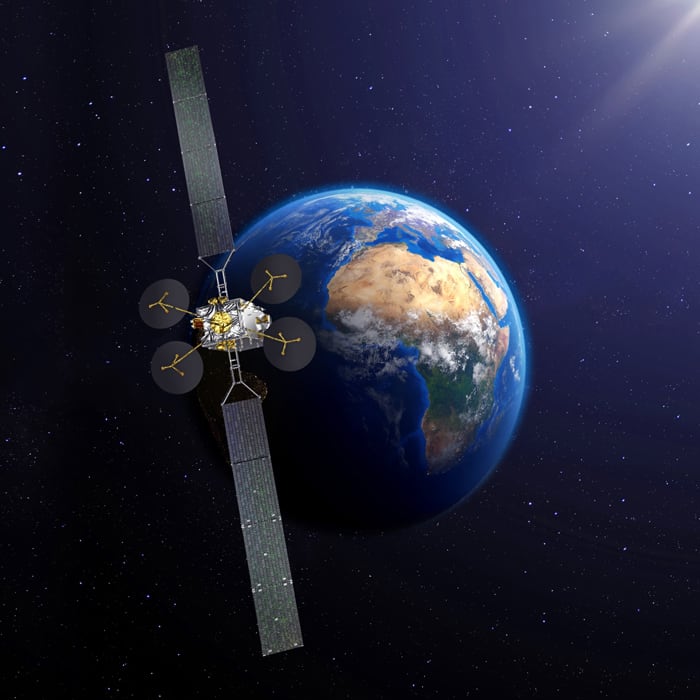
Built by Thales Alenia Space, the Eutelsat Konnect spacecraft will provide broadband connectivity over Europe and Africa during a mission slated to last at least 15 years.
Eutelsat Konnect is the first spacecraft built on the new Spacebus Neo satellite bus, which was developed by Thales with funding from the European Space Agency and the French government, including the French space agency, CNES.
“Creating Spacebus Neo, a completely new product line, and in parallel meeting the schedule of the first satellite Konnect has been quite a challenge, which Thales Alenia Space and its consortium have brilliantly mastered,” said Magali Vaissiere, director of ESA’s telecommunications programs.
“This has only been possible through the successful cooperation between Thales Alenia Space and the agencies ESA and CNES, who have co-managed this project, the excellent coordination with Eutelsat, and the continued support of our European member states.
ESA helped fund development through the space agency’s Neosat program, which aims to develop new European satellite designs with reduced cost and increased capabilities, ensuring Europe’s large satellite manufacturing base remains competitive in the global market.
ESA’s Neosat program supported the development of new satellite platforms by Thales and Airbus Defense and Space. Eutelsat, the largest commercial European satellite operator, agreed to be the first customer for both of the new satellite designs.
Eleven satellites based on the new spacecraft designs pioneered by the Neosat program have been sold by Thales and Airbus to date.
“This is a tremendous success,” said Jan Woerner, ESA’s director general, who attended Thursday’s launch in French Guiana.
The Thales Spacebus Neo satellite platform debuted with Thursday’s launch, and the Airbus Eurostar Neo platform will launch for the first time in 2021.
The Spacebus Neo platform features an all-electric propulsion system with xenon-fueled ion thrusters to perform all the satellite’s post-launch maneuvers.
The low-thrust, high-efficiency xenon jets mean it will take several months for the Eutelsat Konnect satellite to reach its final operating station in geostationary orbit, but the all-electric propulsion system comes with major benefits.
“Eutelsat Konnect is the first satellite to use the Spacebus Neo electric propulsion platform from Thales Alenia Space,” said Peter Newell, Eutelsat Konnect’s program manager at Eutelsat. “Satellites using electric propulsion provide effective solutions for satellite operators, allowing them to maximize the payload capability of the satellite while maintaining a low overall spacecraft mass.
“As the first of its kind, there have many challenges during the development, qualification, manufacturing and test phases, but thanks to the skill and expertise of the Thales, Eutelsat and ESA/CNES teams, the satellite has been brought conception to today’s launch in just four years, which is a great achievement.”
The Eutelsat Konnect spacecraft, which rode in the upper position of the Ariane 5 launcher’s payload bay, weighed 7,978 pounds (3,619 kilograms) at liftoff, significantly less than a similarly-capable communications satellite that used conventional chemical hydrazine fuel.
The Spacebus Neo satellite platform joins other all-electric geostationary satellite buses currently flying from other satellite manufactures, including Boeing, Maxar and Northrop Grumman.
The xenon propulsion package was developed by Thales teams in the United Kingdom, and the payload module comes from a facility in Toulouse, France. Final assembly of the Eutelsat Konnect satellite occurred at a Thales site in Cannes, France.
Eutelsat Konnect is expected to enter commercial service this fall after the slow, multi-month orbit-raising campaign.
The high-power satellite hosts a Ka-band communications payload with a total capacity of 75 gigabits per second, providing Internet services for individuals and companies in Europe and Africa. Eutelsat Konnect will also link with public WiFi hotspots in Africa to provide Internet service to mobile phones and other devices.
“I am proud because with Eutelsat Konnect we are pursuing a great mission,” said Yohann Leroy, chief technology officer at Eutelsat. “Being able to communicate and access information is a fundamental right, and providing everybody on this planet with that right should be a priority.
“This new bird has been designed precisely to contribute to the (fight) against the digital divide, and is aimed at providing broadband Internet to hundreds of thousands of people who are today out of the reach of any terrestrial connectivity across 55 countries in Africa and Europe,” Leroy said.
“Initially, Eutelsat Konnect will operate in both Europe and Africa combined, but thanks to the high flexibility… it will be possible in the future to reallocate all of the satellite capacity to the African market,” Newell said.
After releasing the Eutelsat Konnect spacecraft, the Ariane 5’s upper stage re-oriented itself for separation of GSAT 30, the smaller of the two payloads on Thursday’s launch.
The 7,400-pound (3,357-kilogram) GSAT 30 spacecraft, built and operated by the Indian Space Research Organization, will replace the aging Insat 4A spacecraft, which launched in 2005 on a previous Ariane 5 mission.
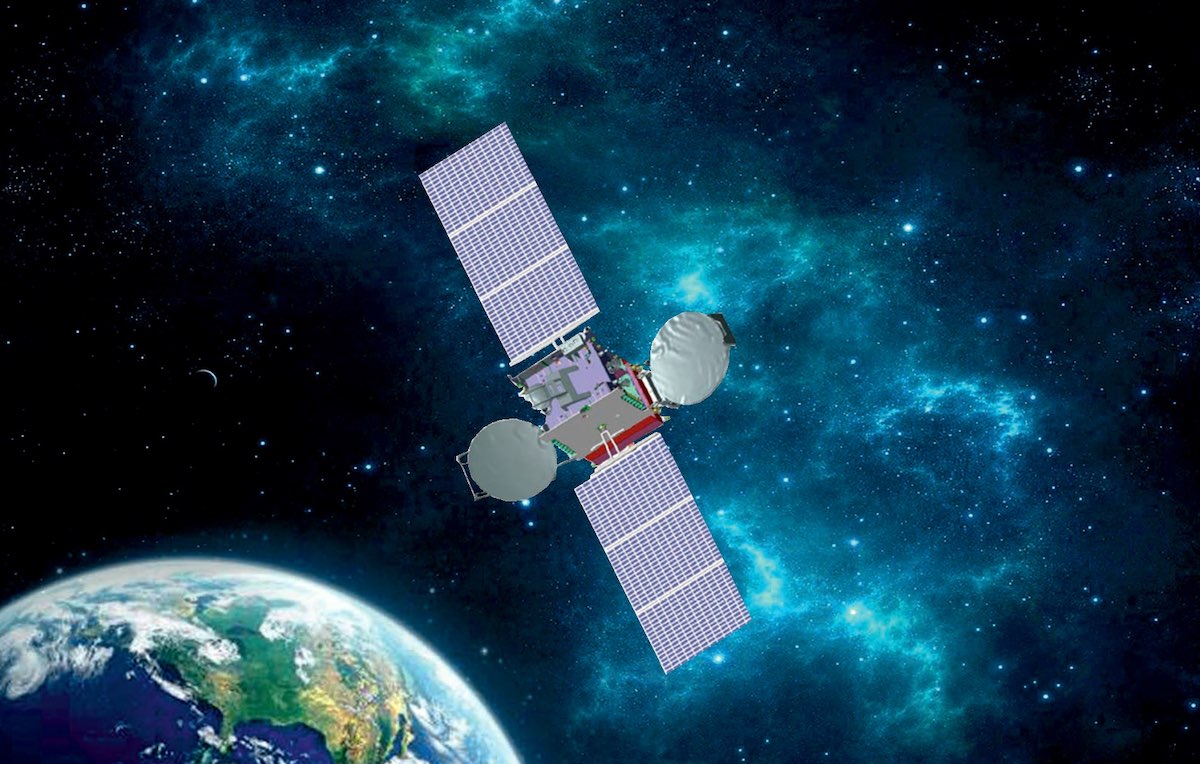
GSAT 30 will operate from a position in geostationary orbit at 83 degrees east longitude over the equator.
“GSAT 30 will provide continuity of direct-to-home TV services from this slot, as well as digital satellite news-gathering and very small aperture terminal services,” said K. Sivan, ISRO’s chairmen. “The Ku-band transponders will provide services over the Indian mainland and islands.
“The satellite employs high-power amplifier and state-of-the-art antenna systems to meet the requirements of multiple users,” Sivan said.
“The GSAT 30 communications payload is equipped with 12 C-band transponder and 12 Ku-band trapsonders,” said D.K. Das, director of ISRO’s Satellite Applications Center. “The C-band transponders are designed for two-way communications using VSAT terminals over a vast geographic region extending up to Australia in the east and Europe in the west.”
Email the author.
Follow Stephen Clark on Twitter: @StephenClark1.


